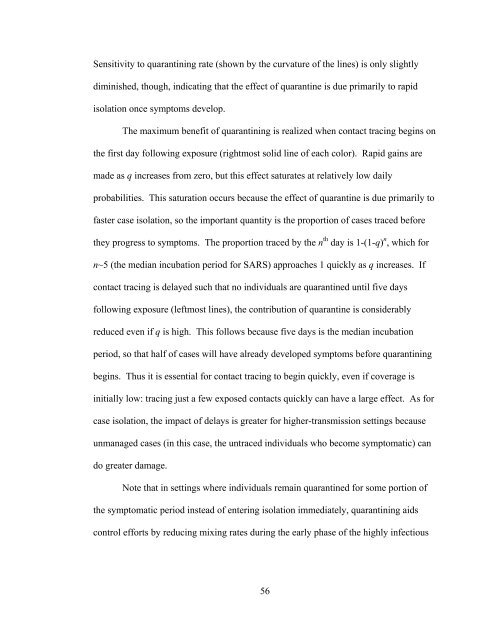K - College of Natural Resources - University of California, Berkeley
K - College of Natural Resources - University of California, Berkeley
K - College of Natural Resources - University of California, Berkeley
You also want an ePaper? Increase the reach of your titles
YUMPU automatically turns print PDFs into web optimized ePapers that Google loves.
Sensitivity to quarantining rate (shown by the curvature <strong>of</strong> the lines) is only slightly<br />
diminished, though, indicating that the effect <strong>of</strong> quarantine is due primarily to rapid<br />
isolation once symptoms develop.<br />
The maximum benefit <strong>of</strong> quarantining is realized when contact tracing begins on<br />
the first day following exposure (rightmost solid line <strong>of</strong> each color). Rapid gains are<br />
made as q increases from zero, but this effect saturates at relatively low daily<br />
probabilities. This saturation occurs because the effect <strong>of</strong> quarantine is due primarily to<br />
faster case isolation, so the important quantity is the proportion <strong>of</strong> cases traced before<br />
they progress to symptoms. The proportion traced by the n th day is 1-(1-q) n , which for<br />
n~5 (the median incubation period for SARS) approaches 1 quickly as q increases. If<br />
contact tracing is delayed such that no individuals are quarantined until five days<br />
following exposure (leftmost lines), the contribution <strong>of</strong> quarantine is considerably<br />
reduced even if q is high. This follows because five days is the median incubation<br />
period, so that half <strong>of</strong> cases will have already developed symptoms before quarantining<br />
begins. Thus it is essential for contact tracing to begin quickly, even if coverage is<br />
initially low: tracing just a few exposed contacts quickly can have a large effect. As for<br />
case isolation, the impact <strong>of</strong> delays is greater for higher-transmission settings because<br />
unmanaged cases (in this case, the untraced individuals who become symptomatic) can<br />
do greater damage.<br />
Note that in settings where individuals remain quarantined for some portion <strong>of</strong><br />
the symptomatic period instead <strong>of</strong> entering isolation immediately, quarantining aids<br />
control efforts by reducing mixing rates during the early phase <strong>of</strong> the highly infectious<br />
56

















